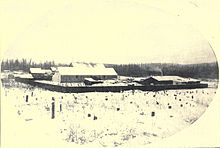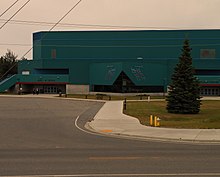Fairbanks
Fairbanks (from Tanana: Tanan) is a city located in Alaska, United States. As of the 2007 census, the population of the city was 34,540 and the total population of Fairbanks and the surrounding area is 97,484. Fairbanks is the largest city in Interior Alaska and the second most largest in the state, after Anchorage. In it is the University of Alaska Fairbanks, the oldest in the state.
History
Fairbanks, the second largest city in Alaska, dates back to the founding of a trading post by Captain E. T. Barnette on August 26, 1901, along with his party and supplies, were deposited along the banks of the Chena River, located 11 miles upstream from its confluence with the Tanana River. The area had seen human occupation since at least the last ice age, but a permanent settlement was not established on the Fairbanks site until the XX. The sight of smoke from steam engines caught the attention of prospectors working in the hills to the north, especially an Italian immigrant named Felice Pedroni (known as Felix Pedro) and his partner Tom Gilmore. The two met Barnette, where he landed him and convinced him of the area's potential. Barnette established his trading post on the site, intending to reach Tanacross.Teams of prospectors soon massed in and around the newly founded Fairbanks; They built drift mines, dredges, and mud mines, as well as panning and locks.
After a few moments from James Wickersham, who later moved the seat of the Eagle Third Division Courthouse to Fairbanks, the establishment was named for Charles Warren Fairbanks, a Republican senator from Indiana and later the Twenty-sixth Vice President of the United States during Theodore Roosevelt's second term.
In these early years of settlement, the Tanana Valley was an important agricultural center for Alaska until the establishment of the Matanuska Valley Settlement Project and the town of Palmer in 1935. Agricultural activity still occurs today in the Tanana Valley, but mostly southeast of Fairbanks in the communities of Salcha and Delta Junctionde. During the early days of Fairbanks, his neighborhood was a large producer of agricultural products. What is now the northern part of southern Fairbanks was originally the farm of Paul J. Rickert, who came from near Chena in 1904 and operated a large farm until his death in 1938. At Farmers Loop Road and Badger Road, the loop of highways north and east (respectively) of Fairbanks, were also home to extensive agricultural activity. Badger Road is named for Harry Markley's badger, an early Fairbanks resident who later established a farm along the highway and became known as 'The Strawberry King'. Ballaine & McGrath Roads, are secondary roads off Farmers Loop Road, were also named for prominent local farmers whose farms are located in the immediate vicinity of their respective namesake roads. Despite initial efforts by the Alaska Loyal League, the Tanana Valley Agricultural Association, and William Fentress Thompson, editor of the Fairbanks Daily News-Miner, to encourage food production, Agriculture in the area, which was never able to fully support the population, came close in the 1920s.
The construction of Ladd Military Airfield beginning in 1939, part of a larger effort by the federal government during the New Deal and World War II to put major infrastructure in the territory for the first time, fostered an economic boom and of population in Fairbanks that extended beyond the end of the war. The Haines - Fairbanks Petroleum Products Pipeline 626 miles long 8 kilometers "was built during the period of 1953-55. The United States Army presence has remained strong in Fairbanks. Ladd became Fort Wainwright in 1960; the post was incorporated into the City of Fairbanks during the 1980s.
Fairbanks suffered extensive flooding in its first six decades, either from ice jams during spring breakup or due to heavy rains. The first bridge to cross the Chena River was a wooden structure built in 1904 to extend Turner Street north to connect with roads leading to the gold mining fields. It was frequently destroyed by river flooding, until a permanent bridge was built on Cushman Street in 1917 by the Alaska Highway Commission. On August 14, 1967, after record rainfall upstream, the Chena River leaped its margins, flooding almost the entire city of Fairbanks overnight. This disaster led to the creation of the Chena River Lakes Flood Control Project, which built and operates the 15-meter-high Moose Creek Dam on the Chena River and the accompanying spillway 8 miles (13 km) deep. long. The project was designed to prevent a repeat of the 1967 flood by diverting water upstream of Fairbanks into the Tanana River, thus bypassing the city.
Geography
Also located on the north and south banks of the Chena River, near its confluence with the Tanana River.
According to the United States Census Bureau, the city has a total area of 84.6 square kilometers. 82.5 km² is land and 2.1 km² is water (2.48% is water).
Climate
Fairbanks has a subpolar climate (Köppen Dfb). The "Inland", Fairbanks region and Denali National Park and Preserve, have some of the most extreme and variable weather in the world with rapid swings in temperature, storms with hail, lightning and snow in summer. The winters are very long, from the end of September to the middle of April; severely cold and dry, with temperatures down to -54 °C. Frequently the temperature is for whole months below -17 °C. The absolute minimum recorded in Fairbanks was -54.4 °C on January 14, 1934. The average minimum for January is -28 °C and its average maximum is -19 °C. The average winter snowfall is 171 cm per year. During the winter months, if the temperature drops below -29°C, sleet can occur. Summers are usually very hot, with Tº frequently reaching 27 to 32 °C and sometimes 32 to 37 °C. The average minimum in July is 12 °C and its average maximum is 22 °C. Fairbanks' absolute maximum was 37.2 °C on July 28, 1919. Thunderstorms with hail and lightning can occur in summer. In August and September it can rain, and snow appears frequently in September. In spring, it snows going into May, and sometimes even into June. The average annual precipitation is 26.26 cm/year (rain plus melted snow). Fairbanks is known for its very long summer days: the sun stays 9:49 p.m. on June 21 with 24 hours of useful sunlight. By opposition, the sun rises at 3:42 a.m. on December 21 with 5:33 a.m. of daylight.
According to the New York Times, spectacular aurora borealis ("northern lights") displays are visible an average of 200 days a year in the Fairbanks neighborhood. (Jerry Garrett, "The Fairbanks Alaska Cold Show," New York Times, March 2, 2007)
| Month | Ene. | Feb. | Mar. | Open up. | May. | Jun. | Jul. | Ago. | Sep. | Oct. | Nov. | Dec. | Annual |
|---|---|---|---|---|---|---|---|---|---|---|---|---|---|
| Temp. max. abs. (°C) | 11.1 | 10 | 13.3 | 24.4 | 32.2 | 35.6 | 37.2 | 33.9 | 28.9 | 22.2 | 12.2 | 14.4 | 37.2 |
| Average temperature (°C) | -17.4 | -11.3 | -3.9 | 7.6 | 16.7 | 22.1 | 22.6 | 19.1 | 12.9 | 1.2 | -10.9 | -15.4 | 3.6 |
| Average temperature (°C) | -22.4 | -17.7 | -11.8 | 0.9 | 10.2 | 16.1 | 17.2 | 13.9 | 7.7 | -3.2 | -15.5 | -20.2 | -2.1 |
| Temp. medium (°C) | -27.3 | -24 | -19.7 | -5.7 | 3.7 | 10.1 | 11.7 | 8.7 | 2.3 | -7.6 | -20.1 | -25 | -7.7 |
| Temp. min. abs. (°C) | -54.4 | - 50. | - 48.9 | -35.6 | -18.3 | -2.2 | -1.1 | -6.1 | -16.1 | -33.3 | - 47.8 | -52.2 | <td style="border-left-width:medium; background:#FFFFFF;color:#'|
| Total precipitation (mm) | 15.5 | 13.2 | 10.2 | 8.6 | 13.7 | 37.6 | 57.4 | 53.3 | 34.3 | 19.3 | 18.8 | 14.5 | 296.4 |
| Nevadas (cm) | 25.9 | 25.4 | 16.5 | 7.9 | 2.3 | 0 | 0 | 0 | 5.8 | 20.8 | 31.8 | 27.7 | 164.1 |
| Days of precipitation (≥ 0.01 in) | 8.7 | 6.9 | 5.7 | 3.7 | 6.2 | 10.8 | 12.8 | 13.5 | 10.7 | 9.8 | 9.5 | 8.8 | 107.1 |
| Days of snowfall (≥ 0.1 in) | 10.2 | 8.3 | 6.7 | 2.6 | 0.6 | 0.0 | 0.0 | 0.0 | 1.3 | 8.3 | 11.2 | 10.4 | 59.6 |
| Hours of sun | 54 | 120 | 224 | 302 | 319 | 334 | 274 | 164 | 122 | 85 | 71 | 36 | 2105 |
| Relative humidity (%) | 69.3 | 65.5 | 60.4 | 56.2 | 50.2 | 56.6 | 64.2 | 70.8 | 68.9 | 74.1 | 72.8 | 71.3 | 65 |
| Source No. 1: | |||||||||||||
| Source No. 2: Danish Meteorological Institute (sun, 1931–1960) | |||||||||||||
Demographics
| Fairbanks Development Graphic between 1910 and 2018 |
 |
According to the 2005 census, there are 82,840 people, of which 52.17% (43,217) are men and 47.83% (39,623) are women. The median age is 29.5 years. The population density is 979.19 hab/km². The racial makeup of the city is 77.79% White, 5.85% Black or African American, 6.9% Native American, 2.08% Asian, 0.3 Pacific Islander, 1.71% from other races, and 5.39% from two or more races. 4.15% are Hispanic or Latino of any race.






